Midland 77-861
In the early eighties, the CB radio craze was at its height, though it was
showing signs of slowing down. Walkie talkies were fun, as they had always been,
and it
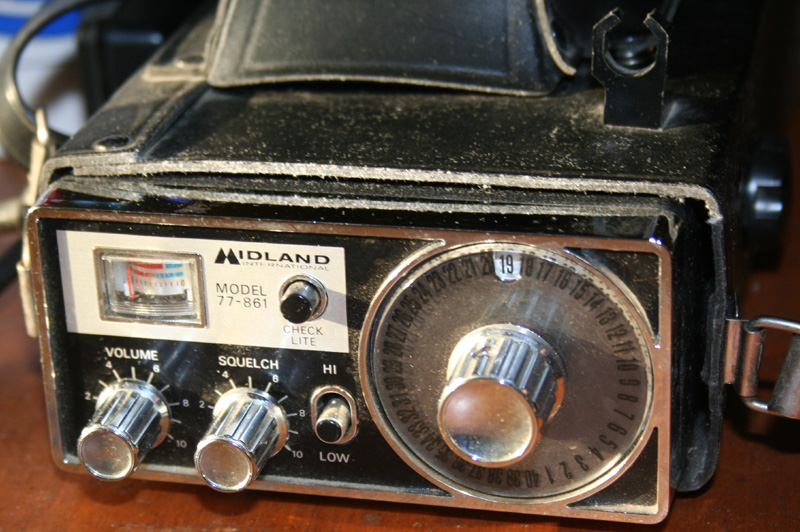 was
great traveling around, with a mobile CB installed in your car. I had taken
several trips with friends, and we had all been CB equipped. It had added to the
fun of the trips, and made planning, stopping, and meeting up with each other
much easier. In addition to this, I had a pretty good base station, with an
excellent antenna, at a good location. There were also walkie talkies, for field
adventures; but something was missing. What I really wanted, was a good portable
unit, better than a walkie talkie, that was not real heavy, and did not require
any kind of elaborate installation. I found it in the Midland 77-861. was
great traveling around, with a mobile CB installed in your car. I had taken
several trips with friends, and we had all been CB equipped. It had added to the
fun of the trips, and made planning, stopping, and meeting up with each other
much easier. In addition to this, I had a pretty good base station, with an
excellent antenna, at a good location. There were also walkie talkies, for field
adventures; but something was missing. What I really wanted, was a good portable
unit, better than a walkie talkie, that was not real heavy, and did not require
any kind of elaborate installation. I found it in the Midland 77-861.
What Midland did, was to take one of
its smaller standard CB radios, and put it in a case, with a 12 volt power
supply, and a groundless antenna. The concept was simple enough, and the unit
was a great performer, which did have a bit of an advantage over my big 40
channel walkie talkies. The unit was in the form of a pack, which would be slung
over the user's shoulder. It only weighed in at a few pounds, and could be set
up with the antenna adjusted vertically or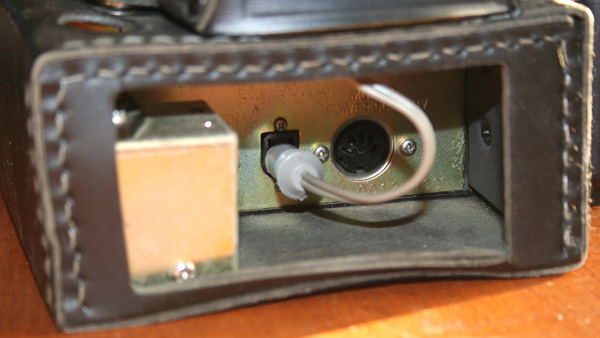 horizontally. This made it possible to put the unit down somewhere and set it up
as a base. The radio itself could also be easily removed from the case, and set
up as a standard mobile CB. It had a standard power and antenna connectors.
horizontally. This made it possible to put the unit down somewhere and set it up
as a base. The radio itself could also be easily removed from the case, and set
up as a standard mobile CB. It had a standard power and antenna connectors.
The radio itself was an enhanced
version of the standard compact CB units being designed for compact
installations. Enhancements included a Hi - low power switch, a battery checker,
and a manual control for the face lighting. It also had, in addition to the
standard 13.8 volt power connector, a 12 volt jack, for use with a power
converter, or the built in battery pack. All of these enhancements were there to
reduce power consumption, and to give the unit a variety of power choices from
which to select. I have used this radio as a portable, with its built in pack,
and as a mobile installed in my car and hooked up to my car's antenna and power.
I have also hooked it up to an AC adapter, extended the antenna, and put it on
the table next to my bed, when I was traveling, but wanted something like a base
unit. Oh, how I would have loved this unit when I was a young boy, and wanted a
base like the adults.
The built in battery pack was
simplicity itself. It consisted of 10 AA rechargeable batteries. the batteries
were charged
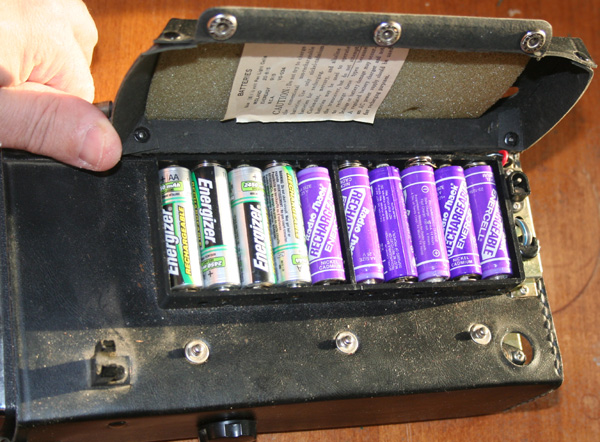 by a
combination charger/power supply, that was included with the unit. Power
consumption was such that you could monitor for several hours on a charge; but
transmitting, particularly at full power, could reduce this time significantly.
This was the reason for the hi - low switch, and for the manual control for the
face light. The unit was designed for rechargeable batteries, which have
slightly lower voltages than standard batteries. A pair of dummy batteries is
included, for the user who does not wish to use rechargeables. The
adapter/charger was plugged into the pack to charge it, or directly into the
back of the radio, when being used as a power supply. With the power on low, or
just for listening, a standard low power typical AC adapter could be used, and
no special power supply was required. Another power saving feature was the old
fashioned circular tuning dial. This was the style of dial used on the older 23
channel units, and had largely been replaced on newer models. On the older
units, this dial had been connected to a multiple pole switch, that selected
between the transmit/receive crystals, for each channel. Newer systems used PLL
(Phase Locked Loop) circuitry, which synthesized channel frequencies, and did
not require a separate set of crystals for each channel. So in the newer models,
a simple switch, changed the channel, which was then displayed on an LED
display. The problem with this, from a power saving standpoint, was that this
LED display used power, and used it constantly. So to avoid this, and as a power
saving feature, Midland went with the older style dial tuning on this model. by a
combination charger/power supply, that was included with the unit. Power
consumption was such that you could monitor for several hours on a charge; but
transmitting, particularly at full power, could reduce this time significantly.
This was the reason for the hi - low switch, and for the manual control for the
face light. The unit was designed for rechargeable batteries, which have
slightly lower voltages than standard batteries. A pair of dummy batteries is
included, for the user who does not wish to use rechargeables. The
adapter/charger was plugged into the pack to charge it, or directly into the
back of the radio, when being used as a power supply. With the power on low, or
just for listening, a standard low power typical AC adapter could be used, and
no special power supply was required. Another power saving feature was the old
fashioned circular tuning dial. This was the style of dial used on the older 23
channel units, and had largely been replaced on newer models. On the older
units, this dial had been connected to a multiple pole switch, that selected
between the transmit/receive crystals, for each channel. Newer systems used PLL
(Phase Locked Loop) circuitry, which synthesized channel frequencies, and did
not require a separate set of crystals for each channel. So in the newer models,
a simple switch, changed the channel, which was then displayed on an LED
display. The problem with this, from a power saving standpoint, was that this
LED display used power, and used it constantly. So to avoid this, and as a power
saving feature, Midland went with the older style dial tuning on this model.
In order to keep things small and
compact, Midland put no speaker in this unit. A speaker would not have worked
properly anyway, as the entire unit was encased. I suppose that a speaker grill
could have been put in the case; but Midland figured out a simpler, more rugged,
and more compact solution. Instead of an internal speaker, Midland used a
somewhat larger than normal mike, and had it double as a speaker. For mobile use
in a car, there is an external speaker jack; but during portable use the speaker
was the mike. The whole unit was an exercise in compact design and flexibility.
During the late seventies/early
eighties, when these units were being sold, the survivalist craze, as well as
the CB craze was in full swing. Many survivalists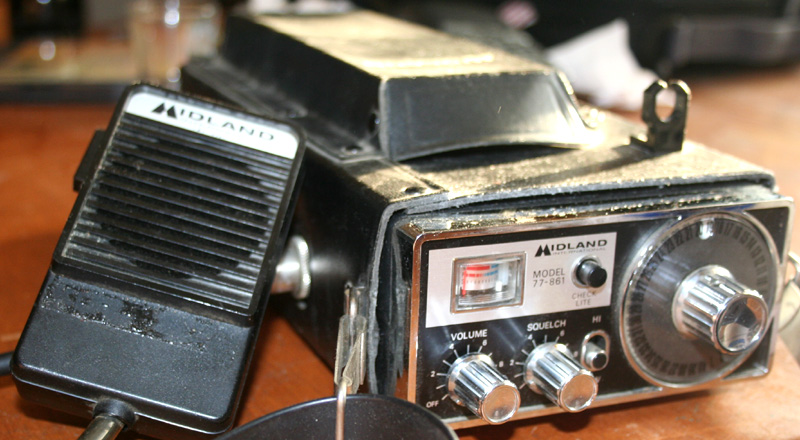 bought these radios, for their small size, low power consumption, all in one
design, and the great flexibility in power sources. The design seemed tailor
made for the retreat, the bug out, or the extended nomadic life. These are units
that can function anywhere. You can connect it to a standard base of mobile
antenna; but a seperate antenna is not required. You can connect it to a car or
home power supply; but it has its own internal power as well. You can hook it up
as a complete base station, with elaborate antenna and power, or just set it on
a table and turn it on. This kind of flexibility, along with the units small
size and low weight, give it a versatility shared by few other units. This model
was preceded by the model 13-861, which was pretty much the same thing; but with
the original 23 channels instead of 40. A photo of both units, side by side, is
below.
bought these radios, for their small size, low power consumption, all in one
design, and the great flexibility in power sources. The design seemed tailor
made for the retreat, the bug out, or the extended nomadic life. These are units
that can function anywhere. You can connect it to a standard base of mobile
antenna; but a seperate antenna is not required. You can connect it to a car or
home power supply; but it has its own internal power as well. You can hook it up
as a complete base station, with elaborate antenna and power, or just set it on
a table and turn it on. This kind of flexibility, along with the units small
size and low weight, give it a versatility shared by few other units. This model
was preceded by the model 13-861, which was pretty much the same thing; but with
the original 23 channels instead of 40. A photo of both units, side by side, is
below.
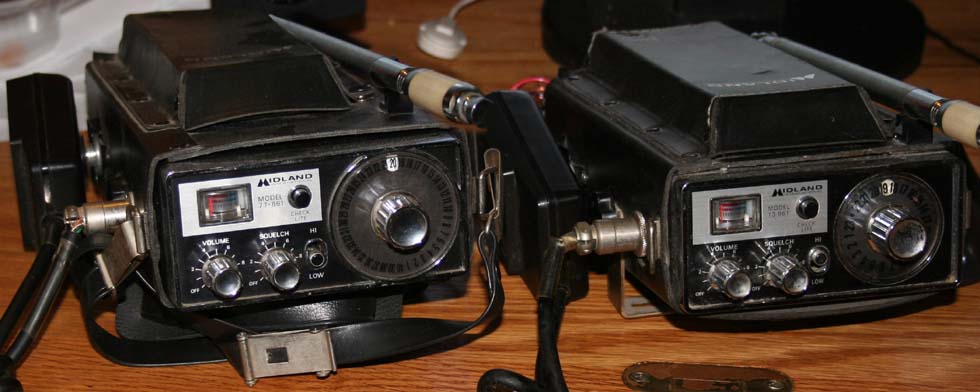
|